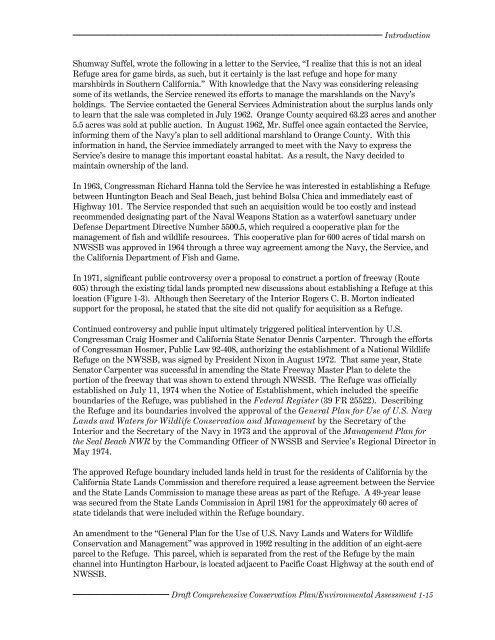Chapters 1 - U.S. Fish and Wildlife Service
Chapters 1 - U.S. Fish and Wildlife Service
Chapters 1 - U.S. Fish and Wildlife Service
Create successful ePaper yourself
Turn your PDF publications into a flip-book with our unique Google optimized e-Paper software.
Introduction<br />
Shumway Suffel, wrote the following in a letter to the <strong>Service</strong>, “I realize that this is not an ideal<br />
Refuge area for game birds, as such, but it certainly is the last refuge <strong>and</strong> hope for many<br />
marshbirds in Southern California.” With knowledge that the Navy was considering releasing<br />
some of its wetl<strong>and</strong>s, the <strong>Service</strong> renewed its efforts to manage the marshl<strong>and</strong>s on the Navy’s<br />
holdings. The <strong>Service</strong> contacted the General <strong>Service</strong>s Administration about the surplus l<strong>and</strong>s only<br />
to learn that the sale was completed in July 1962. Orange County acquired 63.23 acres <strong>and</strong> another<br />
5.5 acres was sold at public auction. In August 1962, Mr. Suffel once again contacted the <strong>Service</strong>,<br />
informing them of the Navy’s plan to sell additional marshl<strong>and</strong> to Orange County. With this<br />
information in h<strong>and</strong>, the <strong>Service</strong> immediately arranged to meet with the Navy to express the<br />
<strong>Service</strong>’s desire to manage this important coastal habitat. As a result, the Navy decided to<br />
maintain ownership of the l<strong>and</strong>.<br />
In 1963, Congressman Richard Hanna told the <strong>Service</strong> he was interested in establishing a Refuge<br />
between Huntington Beach <strong>and</strong> Seal Beach, just behind Bolsa Chica <strong>and</strong> immediately east of<br />
Highway 101. The <strong>Service</strong> responded that such an acquisition would be too costly <strong>and</strong> instead<br />
recommended designating part of the Naval Weapons Station as a waterfowl sanctuary under<br />
Defense Department Directive Number 5500.5, which required a cooperative plan for the<br />
management of fish <strong>and</strong> wildlife resources. This cooperative plan for 600 acres of tidal marsh on<br />
NWSSB was approved in 1964 through a three way agreement among the Navy, the <strong>Service</strong>, <strong>and</strong><br />
the California Department of <strong>Fish</strong> <strong>and</strong> Game.<br />
In 1971, significant public controversy over a proposal to construct a portion of freeway (Route<br />
605) through the existing tidal l<strong>and</strong>s prompted new discussions about establishing a Refuge at this<br />
location (Figure 1-3). Although then Secretary of the Interior Rogers C. B. Morton indicated<br />
support for the proposal, he stated that the site did not qualify for acquisition as a Refuge.<br />
Continued controversy <strong>and</strong> public input ultimately triggered political intervention by U.S.<br />
Congressman Craig Hosmer <strong>and</strong> California State Senator Dennis Carpenter. Through the efforts<br />
of Congressman Hosmer, Public Law 92-408, authorizing the establishment of a National <strong>Wildlife</strong><br />
Refuge on the NWSSB, was signed by President Nixon in August 1972. That same year, State<br />
Senator Carpenter was successful in amending the State Freeway Master Plan to delete the<br />
portion of the freeway that was shown to extend through NWSSB. The Refuge was officially<br />
established on July 11, 1974 when the Notice of Establishment, which included the specific<br />
boundaries of the Refuge, was published in the Federal Register (39 FR 25522). Describing<br />
the Refuge <strong>and</strong> its boundaries involved the approval of the General Plan for Use of U.S. Navy<br />
L<strong>and</strong>s <strong>and</strong> Waters for <strong>Wildlife</strong> Conservation <strong>and</strong> Management by the Secretary of the<br />
Interior <strong>and</strong> the Secretary of the Navy in 1973 <strong>and</strong> the approval of the Management Plan for<br />
the Seal Beach NWR by the Comm<strong>and</strong>ing Officer of NWSSB <strong>and</strong> <strong>Service</strong>’s Regional Director in<br />
May 1974.<br />
The approved Refuge boundary included l<strong>and</strong>s held in trust for the residents of California by the<br />
California State L<strong>and</strong>s Commission <strong>and</strong> therefore required a lease agreement between the <strong>Service</strong><br />
<strong>and</strong> the State L<strong>and</strong>s Commission to manage these areas as part of the Refuge. A 49-year lease<br />
was secured from the State L<strong>and</strong>s Commission in April 1981 for the approximately 60 acres of<br />
state tidel<strong>and</strong>s that were included within the Refuge boundary.<br />
An amendment to the “General Plan for the Use of U.S. Navy L<strong>and</strong>s <strong>and</strong> Waters for <strong>Wildlife</strong><br />
Conservation <strong>and</strong> Management” was approved in 1992 resulting in the addition of an eight-acre<br />
parcel to the Refuge. This parcel, which is separated from the rest of the Refuge by the main<br />
channel into Huntington Harbour, is located adjacent to Pacific Coast Highway at the south end of<br />
NWSSB.<br />
Draft Comprehensive Conservation Plan/Environmental Assessment 1-15

















